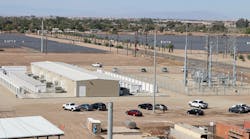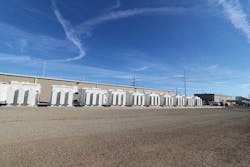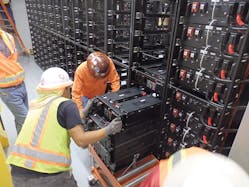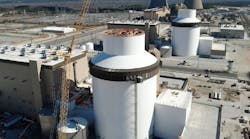The Imperial Irrigation District (IID) has launched a 30-MW/20-MWh lithium-ion battery energy storage system (BESS) that increases reliability across the district’s grid and puts the utility on the forefront of the energy industry’s technological evolution.
For its first BESS project, IID entered into the storage technology in a big way, constructing one of the largest such systems in the western United States. Some of its partners in the project also broke new ground that required teamwork and a focus on solutions. Thanks to the efforts of everyone involved, this complex and innovative project came in under budget and three months ahead of schedule.
Essential Storage
Energy storage systems are essential for utilities to manage the mix of energy sources coming onto the modern grid effectively, particularly in California. Compared to other storage technologies, battery storage systems are becoming widely used because they are efficient, fast-acting and provide the most breadth of services in energy storage.
In this case, battery storage systems improve the ability to integrate IID’s portfolio of renewables, especially new solar photovoltaic plants, into the local grid. The desert valley also is home to geothermal plants and wind farms that, like all renewables, present challenges for managing the energy streams. The battery system provides the needed frequency regulation and power balancing to deal with the fluctuations that come with renewables.
In addition, the battery system enables the district to black-start units at its El Centro generation station and supplement backup energy resources while acting as extra generating capacity, called a spinning reserve. The battery system replaces expensive fossil-fuel generation, which usually serves these purposes with a much faster and more economical alternative.
BESS Response
A BESS can respond in a few cycles, whereas a conventional steam or gas-fired generator may take several minutes. This can make a significant difference when trying to correct frequency issues or meet reliability standards established by the North American Electric Reliability Corporation (NERC).
Another feature of lithium-ion batteries is they can recover quickly. For instance, consider the situation where the BESS is charged at a rate of 30 MW for the next half hour. During that time, the BESS acts like a 30-MW load on the system. This can be useful in helping to keep conventional units on-line during low-load conditions.
Suddenly something may happen that requires emergency power from the system. This could be because of a decrease in solar plant output, an increase in load or the loss of a tie line. With the BESS, the load can be reduced to zero, plus 30 MW can be generated. That results in a 60-MW change in the power coming from that device, or 60-MW dynamic range.
A conventional 30-MW generator goes from 0 MW and 30 MW, and that is it; and it does so slowly. In a matter of a few cycles, the BESS can go from -30 MW to 30 MW. This fast reaction time and the large dynamic range are features that separate a BESS unit from a conventional generator.
Looking Around
IID put its plans for a BESS in motion by researching similar BESS projects already in operation. That search eventually took the district’s representatives to Fairbanks, Alaska. There, the Golden Valley Electric Association (GVEA) was using a 40-MW nickel-cadmium BESS for spinning reserves in case a generator or the single intertie line from Anchorage went down. IID liked what it saw at Fairbanks and called on the same engineering firm that had designed GVEA’s system back in 2003, POWER Engineers. POWER and IID were familiar with each other, as their history of working together dated back to 1991.
A major technical difference for IID compared to GVEA’s system was the need to smooth out energy fluctuations from solar energy sources. POWER also proposed using newer lithium-ion battery technology. Lithium-ion batteries are completely sealed and do not require the electrolyte maintenance needed by nickel-cadmium batteries. In addition, lithium-ion batteries are replaced as soon as they start showing performance issues.
Beginning Design
POWER conducted a load-flow study and created a dynamic model of the BESS in multiple control modes to see how it would perform under different conditions and to evaluate its potential effects on nearby transmission systems. Putting the storage system in the right place would take stress off the rest of the grid and provide reliability options. Technical analysis modeling at two sites showed the best location for the BESS to be at the El Centro generation station, 100 miles (161 km) east of San Diego, California. It also concluded the 30-MW size worked best for the kinds of fluctuations IID was seeing.
One of the decisions IID faced was whether to have the battery system built in a factory and delivered to the site in large containers ready to be mounted on concrete pads or to build its system on-site. Among the reasons IID eventually decided to build the storage system from the ground up were separate containers would have required separate cooling systems and housing the system in a building offered more working room. IID tapped POWER Engineers as its owner’s engineer and to generate the request for proposals for the BESS.
System Engineering
Coachella Energy Storage Partners (CESP) won the engineering and construction bid, and CESP hired General Electric to deliver a complete energy storage system. GE supplied all the inverters, controls and transformers, and purchased the lithium-ion batteries, originally developed for the electric vehicle industry, from Samsung SDI America. CESP also engaged Chula Vista Electric Co. to construct the associated substation. ZGlobal represented CESP as its owner’s engineer and performed the design, testing, integration and overall project engineering.
Regular on-site meetings helped to cement coordination and cooperation among the many teams. An approach focused on solutions was important because the BESS project represented a number of firsts. Not only was this IID’s first BESS project, it was the first for CESP. Although this was GE’s third project using lithium-ion battery technology, it was its largest energy storage project and the first to be built on-site.
The project also resulted in GE updating the specifications of its inverters. GE proposed a certain number of inverters based on its standard temperature rating. But the BESS specification called for a design temperature that exceeded the GE inverter temperature range. GE quickly retested its inverters under the new hotter conditions and requalified them. Now all of GE’s inverters are at a higher rating.
BESS Facility Construction
Construction of the BESS facility involved many contractors — up to 60 at one point — across several disciplines. Delays could be costly, so IID called on POWER Constructors Inc. (PCI), a POWER Engineers’ subsidiary, to monitor contractors’ work. In addition to monitoring construction, PCI ensured the electronic equipment was carefully off loaded on arrival, inspected for damage and staged in a safe place before being installed.
IID and Coachella representatives broke ground for the project in November 2015, a time of year when Imperial Valley temperatures are relatively mild. However, construction would extend through the following summer, a season when valley temperatures often hover well above 100°F (38°C).
Higher temperatures can result in concrete setting too rapidly and cracking. When daytime temperatures began to rise, workers poured the 300 truckloads of cement needed for three large pads during the cooler nights. This pouring schedule also provided the advantage of inspecting the work in the daylight to address any issues.
The BESS facility that rose on the site included an 8000-sq ft (2438-sq m) building that contains 5000 batteries and controls. To keep the facility cooled to 70°F (158°C) at all times required 200 tons of air conditioning provided by heat pumps. The cooling system is designed so any single component failure in the system will still enable the BESS to operate at 100%. Outside the building, there are 30 1.25-MW transformers and inverters, plus one 33-MVA main transformer.
Commission and Operation
Each set of batteries is connected to an inverter, which is connected to a transformer as a separate storage system capable of operating independently. The 30 inverters and 30 transformers then are connected to create the total system. Commissioning demonstrated the BESS synchronized with the utility’s operations and produced the rated output, both for the 30-MWh and 20-MWh requirements. The teams met the challenge by making all of them operate as one unit.
IID’s project illustrates how a BESS can be deployed to solve a variety of grid challenges while responding to demand changes. Coordinating the battery system with conventional generators gives the best of both worlds — fast response and sustained energy — which neither system alone can achieve. ♦
Chris Beltran is the general superintendent in charge of operations and maintenance at Imperial Irrigation District’s generation facilities. With more than 30 years of renewable and traditional energy generation and operator experience, Beltran is well positioned to lead IID’s generation efforts as new technology and resources become available.
Hector Esquer is an experienced project manager skilled in energy-use analysis, power engineering, construction of combined heat and power systems, energy-efficiency projects and renewable energy technologies. He has managed engineering, procurement and construction projects as well as turnkey projects for a variety of energy, commercial, military and hospitality clients. Esquer is experienced in contractor selection, project construction and commissioning.
Sidebar: IID’s BESS by the Numbers
- 5000 lithium-ion batteries
- Battery size of a desktop computer and weight of 100 lb (45 kg) each
- Total weight of 252 tons
- Anticipated battery life of 18 to 20 years
- Nominal voltage 92 kV
- Normal sustained voltage between 0.95 pu minimum and 1.05 pu maximum
- Frequency of 60 Hz with normal deviation of 5 Hz
- Sustained frequency range between 57 Hz minimum and 63 Hz maximum





